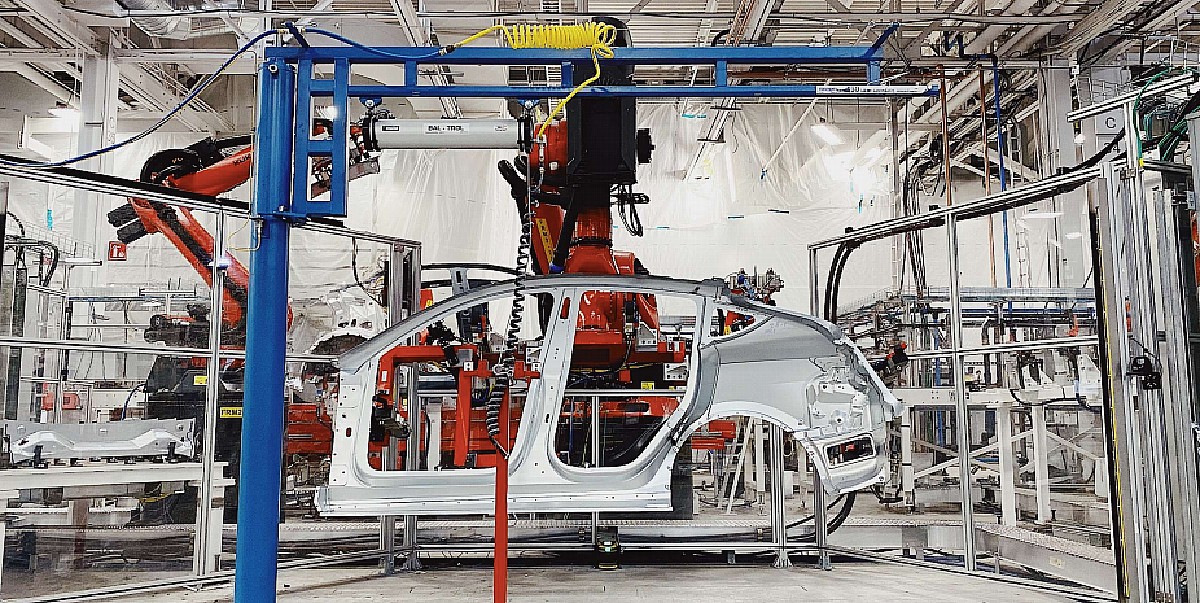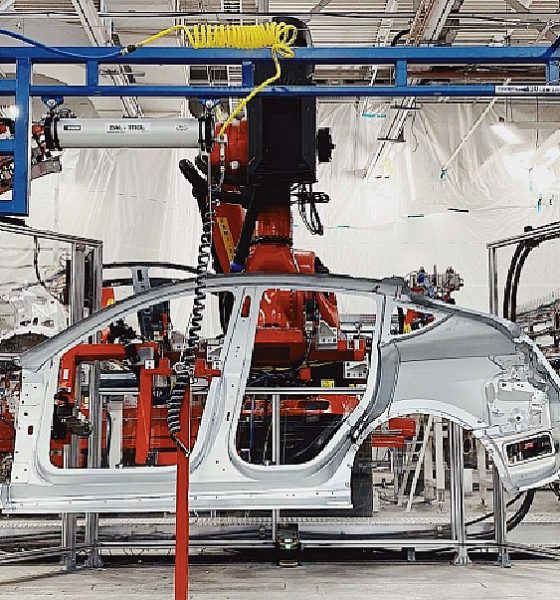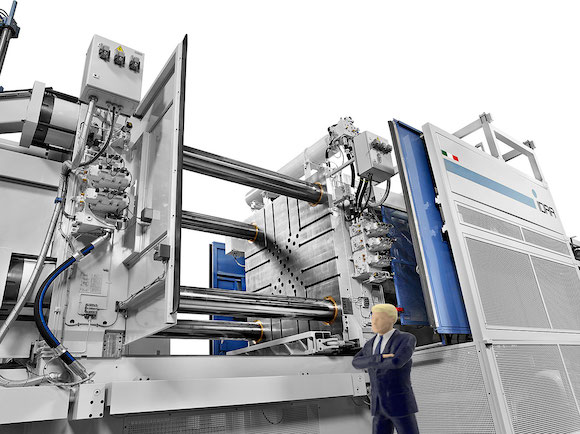

News
Tesla takes a step towards the Model Y’s single-piece cast with 410-ton machine purchase
When Elon Musk was interviewed in an episode of the Third Row Podcast earlier this year, he noted that the Model Y crossover’s rear underbody would eventually be built with a single-piece casting. This is quite a bold target, and one that can make the Model Y into one of the most cost-effective vehicles on the market today, electric or otherwise.
“The current version of Model Y has basically two big high-pressure diecast [HPDC] aluminum castings that are joined and there’s still a bunch of other bits that are attached. Later this year. We’ll transition to the rear underbody being a single-piece casting that also integrates the rear crash rails,” Musk remarked.
There are many advantages to using a single-piece cast for the Model Y. The vehicle could be built in a relatively simple manner by using fewer parts, helping the company optimize its production costs. Developing such a design only takes a lot of time and effort, as indicated by Elon Musk in the podcast.
“It gets better. The current castings, because you’ve got to interface with so many different things, we have to CNC-machine the interfaces and there’s a bunch of things that have to be joined; they have datums on them and that kind of thing. The single-piece casting has no CNC machining – it doesn’t even have datums. It took us a lot of iterations, by the way, to get there,” the CEO added.

It appears that Tesla is now at a point where it is ready to pursue the Model Y’s single-piece cast. As indicated in a recent report on SAE Automotive Engineering, Tesla has purchased a machine from the IDRA Group, an Italian firm that makes HPDC equipment. What is rather interesting is that the machine that Tesla purchased is a gargantuan piece of equipment capable of producing the Model Y’s special components.
The machine that Tesla purchased, called the IDRA OL6100 CS, features an upgraded locking force that’s specially designed for the Model Y’s castings. Interestingly enough, the OL6100 CS is fondly dubbed as the “Giga Press” due to its size and power. The machine is 64 feet long and 17 feet high, and it weighs a whopping 410 tons. That’s roughly as heavy as five Space Shuttles.
Laurie Harbour, president at Harbour Results Inc., a manufacturing consultancy firm, noted that the new machine could effectively optimize the Model Y’s production process. With the Giga Press in use, Harbour estimates that Tesla could save about 20% on labor cost.
“Even with a big cycle time, you eliminate all the labor to assemble pieces and subcomponents. You’re saving on automation cells, you’re saving on people. It would be tough to put dollars to it, but think of multiple suppliers doing stampings, you could save maybe 20% on labor cost. And reduction in footprint is major. My guess is that it’s a net-net efficiency gain,” she said.
What is particularly interesting is that the Model Y was already highly optimized to begin with. Unlike the early production Model 3, which featured over 70 pieces in its rear underbody, early production Model Ys only had two large casts at the rear. This was confirmed by automotive teardown expert Sandy Munro, who conducted a thorough teardown of the Tesla Model Y from top to bottom.
Reflecting on the Model Y’s current casts, Munro noted that the vehicle had “two of the biggest castings we’ve ever seen in a car,” especially one in a consumer vehicle the size of the all-electric crossover. The teardown expert stated that other companies, such as BMW and Audi, have all used castings, but nothing comes close to the one that Tesla currently uses in the Model Y. And once Tesla moves to a single-piece casting system for the vehicle, Munro noted that the American electric car maker could “win the price.”

News
Tesla FSD fleet is nearing 7 billion total miles, including 2.5 billion city miles
As can be seen on Tesla’s official FSD webpage, vehicles equipped with the system have now navigated over 6.99 billion miles.

Tesla’s Full Self-Driving (Supervised) fleet is closing in on almost 7 billion total miles driven, as per data posted by the company on its official FSD webpage.
These figures hint at the massive scale of data fueling Tesla’s rapid FSD improvements, which have been quite notable as of late.
FSD mileage milestones
As can be seen on Tesla’s official FSD webpage, vehicles equipped with the system have now navigated over 6.99 billion miles. Tesla owner and avid FSD tester Whole Mars Catalog also shared a screenshot indicating that from the nearly 7 billion miles traveled by the FSD fleet, more than 2.5 billion miles were driven inside cities.
City miles are particularly valuable for complex urban scenarios like unprotected turns, pedestrian interactions, and traffic lights. This is also the difference-maker for FSD, as only complex solutions, such as Waymo’s self-driving taxis, operate similarly on inner-city streets. And even then, incidents such as the San Francisco blackouts have proven challenging for sensor-rich vehicles like Waymos.
Tesla’s data edge
Tesla has a number of advantages in the autonomous vehicle sector, one of which is the size of its fleet and the number of vehicles training FSD on real-world roads. Tesla’s nearly 7 billion FSD miles then allow the company to roll out updates that make its vehicles behave like they are being driven by experienced drivers, even if they are operating on their own.
So notable are Tesla’s improvements to FSD that NVIDIA Director of Robotics Jim Fan, after experiencing FSD v14, noted that the system is the first AI that passes what he described as a “Physical Turing Test.”
“Despite knowing exactly how robot learning works, I still find it magical watching the steering wheel turn by itself. First it feels surreal, next it becomes routine. Then, like the smartphone, taking it away actively hurts. This is how humanity gets rewired and glued to god-like technologies,” Fan wrote in a post on X.
News
Tesla starts showing how FSD will change lives in Europe
Local officials tested the system on narrow country roads and were impressed by FSD’s smooth, human-like driving, with some calling the service a game-changer for everyday life in areas that are far from urban centers.

Tesla has launched Europe’s first public shuttle service using Full Self-Driving (Supervised) in the rural Eifelkreis Bitburg-Prüm region of Germany, demonstrating how the technology can restore independence and mobility for people who struggle with limited transport options.
Local officials tested the system on narrow country roads and were impressed by FSD’s smooth, human-like driving, with some calling the service a game-changer for everyday life in areas that are far from urban centers.
Officials see real impact on rural residents
Arzfeld Mayor Johannes Kuhl and District Administrator Andreas Kruppert personally tested the Tesla shuttle service. This allowed them to see just how well FSD navigated winding lanes and rural roads confidently. Kruppert said, “Autonomous driving sounds like science fiction to many, but we simply see here that it works totally well in rural regions too.” Kuhl, for his part, also noted that FSD “feels like a very experienced driver.”
The pilot complements the area’s “Citizen Bus” program, which provides on-demand rides for elderly residents who can no longer drive themselves. Tesla Europe shared a video of a demonstration of the service, highlighting how FSD gives people their freedom back, even in places where public transport is not as prevalent.
What the Ministry for Economic Affairs and Transport says
Rhineland-Palatinate’s Minister Daniela Schmitt supported the project, praising the collaboration that made this “first of its kind in Europe” possible. As per the ministry, the rural rollout for the service shows FSD’s potential beyond major cities, and it delivers tangible benefits like grocery runs, doctor visits, and social connections for isolated residents.
“Reliable and flexible mobility is especially vital in rural areas. With the launch of a shuttle service using self-driving vehicles (FSD supervised) by Tesla in the Eifelkreis Bitburg-Prüm, an innovative pilot project is now getting underway that complements local community bus services. It is the first project of its kind in Europe.
“The result is a real gain for rural mobility: greater accessibility, more flexibility and tangible benefits for everyday life. A strong signal for innovation, cooperation and future-oriented mobility beyond urban centers,” the ministry wrote in a LinkedIn post.
News
Tesla China quietly posts Robotaxi-related job listing
Tesla China is currently seeking a Low Voltage Electrical Engineer to work on circuit board design for the company’s autonomous vehicles.

Tesla has posted a new job listing in Shanghai explicitly tied to its Robotaxi program, fueling speculation that the company is preparing to launch its dedicated autonomous ride-hailing service in China.
As noted in the listing, Tesla China is currently seeking a Low Voltage Electrical Engineer to work on circuit board design for the company’s autonomous vehicles.
Robotaxi-specific role
The listing, which was shared on social media platform X by industry watcher @tslaming, suggested that Tesla China is looking to fill the role urgently. The job listing itself specifically mentions that the person hired for the role will be working on the Low Voltage Hardware team, which would design the circuit boards that would serve as the nervous system of the Robotaxi.
Key tasks for the role, as indicated in the job listing, include collaboration with PCB layout, firmware, mechanical, program management, and validation teams, among other responsibilities. The role is based in Shanghai.
China Robotaxi launch
China represents a massive potential market for robotaxis, with its dense urban centers and supportive policies in select cities. Tesla has limited permission to roll out FSD in the country, though despite this, its vehicles have been hailed as among the best in the market when it comes to autonomous features. So far, at least, it appears that China supports Tesla’s FSD and Robotaxi rollout.
This was hinted at in November, when Tesla brought the Cybercab to the 8th China International Import Expo (CIIE) in Shanghai, marking the first time that the autonomous two-seater was brought to the Asia-Pacific region. The vehicle, despite not having a release date in China, received a significant amount of interest among the event’s attendees.








